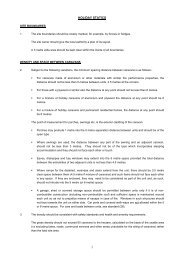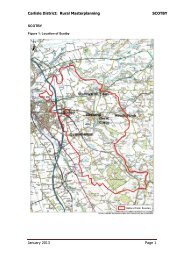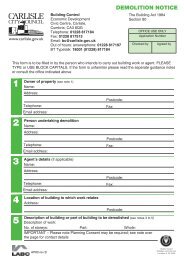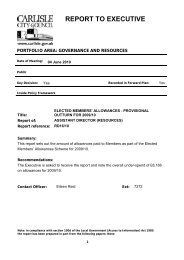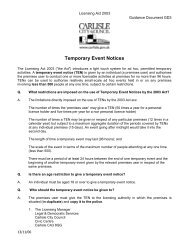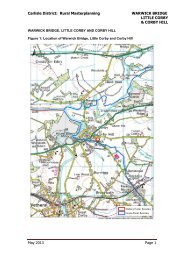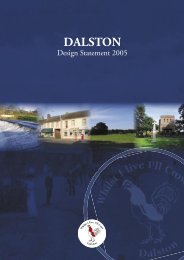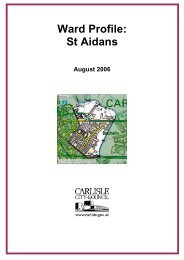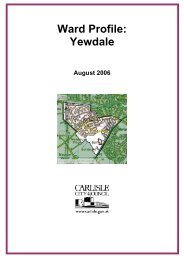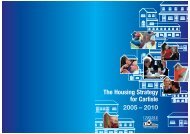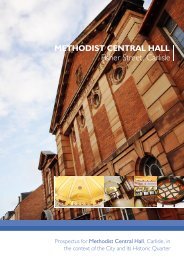Carlisle District Local Plan.indd - Carlisle City Council
Carlisle District Local Plan.indd - Carlisle City Council
Carlisle District Local Plan.indd - Carlisle City Council
Create successful ePaper yourself
Turn your PDF publications into a flip-book with our unique Google optimized e-Paper software.
<strong>Carlisle</strong> <strong>District</strong> <strong>Local</strong> <strong>Plan</strong> 2001 - 2016 Revised Redeposit draft3.56 The proposed five mile (8.25km) long <strong>Carlisle</strong> Northern Development Route to the westand north of the <strong>City</strong> will improve the environment by removing 8,000 through vehicles perday including 600 HGVs. Measurements have shown that the highest rates of emissionsare encountered in congested, slow-moving traffic. This will help to decrease critically highnitrous oxide levels along the main <strong>City</strong> transport arteries. Nitrous oxide safety limits arepredicted to exceed national guidance levels at limited locations of greatest traffic flow in<strong>Carlisle</strong> in 2005. The planting of trees and woodland particularly along transport corridorsis encouraged as a means of removing air-borne pollutants and particulate.3.57 Over the last decade there has been a greater awareness of the adverse effects oflight pollution. There are three main types of light pollution: sky glow, glare and lighttrespass. Intrusive light can cause road safety problems, harm wildlife and createphysiological problems for residents. Such pollution wastes energy and results in theburning of unnecessary fossil fuels by power stations which is unsustainable. CPRE hasgiven publicity to the evidence from satellite data of the spread of light pollution acrossthe country especially into rural areas. This is caused by extensions of street lighting withnew developments, floodlights for sports pitches and buildings, and by security lights onbuildings. The Government has made it clear that the intrusiveness of lighting particularly inthe countryside should be kept to a minimum and has urged that <strong>Local</strong> <strong>Plan</strong>ning Authoritiesrecognise the cumulative adverse impacts of lighting on countryside character whichdecreases the sense of remoteness and blurs the distinction between urban and rural areas.Lighting should be as energy-efficient as possible or run off renewable energy and minimiseupward light pollution. Landscaping measures such as mounding and planting may in somesituations help to protect residential amenity and reduce light spillage and glare.POLICY CP13 Waste Minimisation and the Recycling of WasteResidential developments of 10 or more dwellings, business, industrial or commercialfloorspace of 300 m 2 or more, or retail floorspace of 500 m 2 or more must beaccompanied by a Waste Audit at the planning application submission stage. The auditshall comprise an estimation of the type and volume of waste that the development willgenerate during construction and during occupation, the waste management optionsto be employed to manage this waste and the steps taken to minimise the amount ofwaste arising from the development through reusing and recycling materials. WasteAudits will be assessed by the Waste Collection Authority against the hierarchy ofoptions in the following order of preference:1. reduction in the amount of waste produced;2. re-use of waste on site without significant processing;3. recycling and/or composting of waste on-site;4 recycling and/or composting of waste off-site;5. recovery of value from waste produced;6. landfilling of residual waste.All such planning applications shall also include facilities for the storage, collection andrecycling of waste.3.58 To encourage waste elimination in line with Sustainable Development Policy, including theprinciples set out in Waste Strategy 2000, PPS10, RSS draft Policy EQ8 and ER11, andPolicy R49 of the emerging Cumbria and Lake <strong>District</strong> Joint Structure <strong>Plan</strong> 2001-2016September 2006 41



